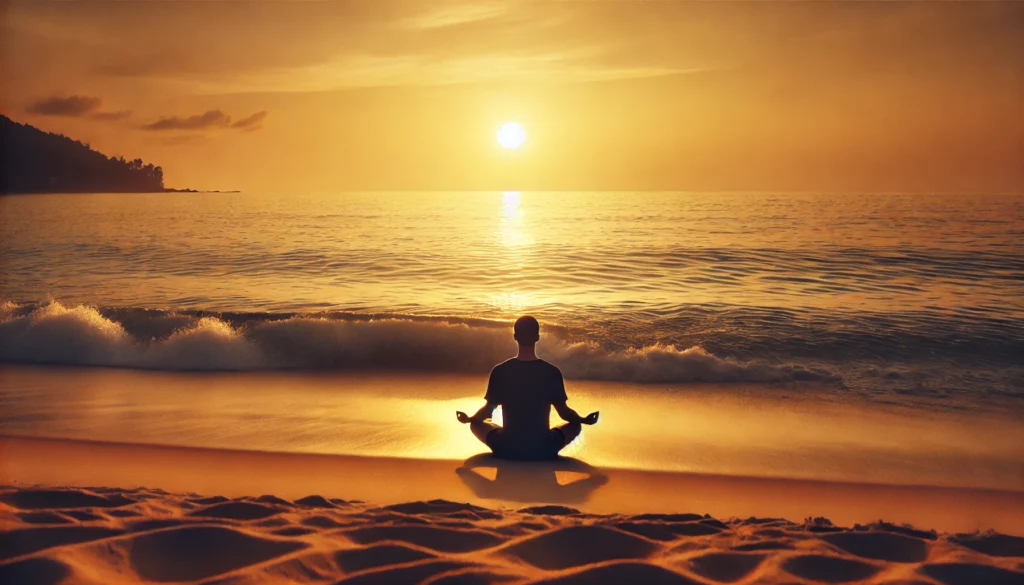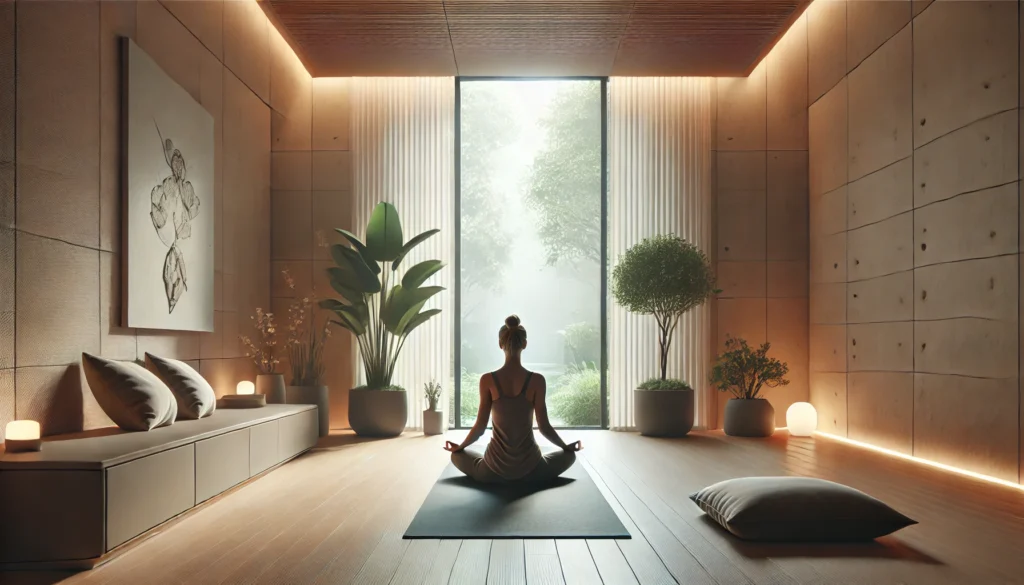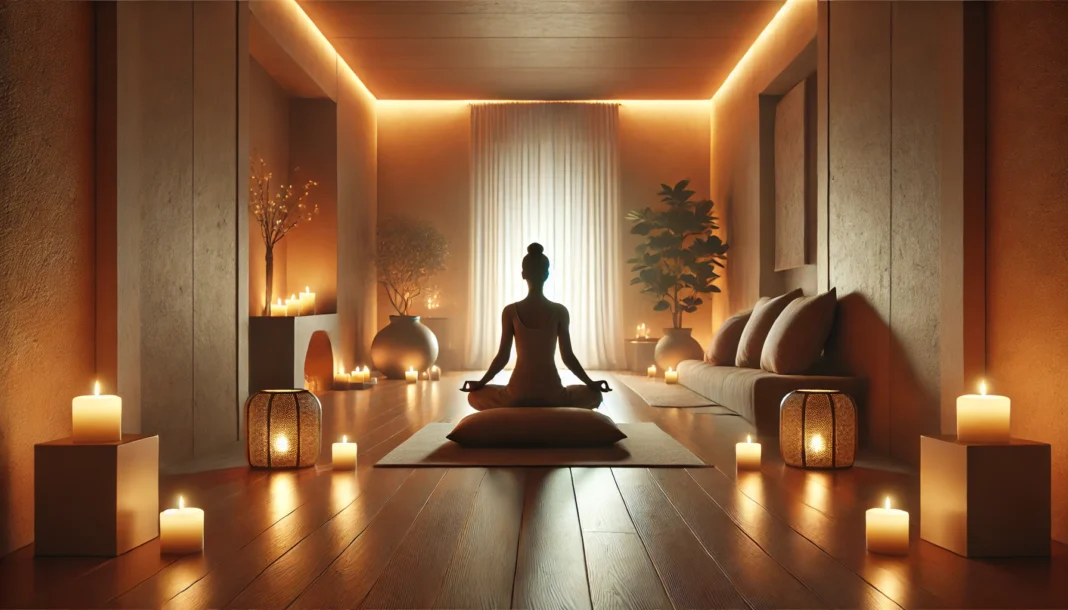Introduction: The Transformative Power of Deep Meditation
Meditation is often associated with relaxation, mindfulness, and heightened self-awareness. However, many people struggle with how to meditate deeply and access a profound state of relaxation and clarity. Achieving deep deep meditation requires a combination of refined techniques, dedication, and an understanding of the mind’s natural tendencies. By mastering deep meditation techniques, individuals can experience the deepest state of meditation, where consciousness expands, the body relaxes, and inner clarity emerges. In this guide, we will explore how to go into deep meditation, the benefits of deep relaxation meditation, and how to enter a deep meditative state using advanced strategies.
You may also like: The Science Behind Meditation: How It Transforms Mental and Physical Health
Understanding the State of Deep Meditation
The state of deep meditation is characterized by a profound sense of awareness and relaxation. In this state, thoughts slow down, the body enters a deeply restful phase, and the mind becomes free from distractions. Many people wonder how to get into a deep meditative state and sustain it for extended periods. The key lies in proper preparation, breath control, and a gradual deepening of mental focus. Unlike surface-level mindfulness practices, deep meditation therapy involves going beyond everyday awareness to tap into the subconscious and unconscious layers of the mind. By understanding the mechanisms of deep relaxation meditation guided by expert techniques, individuals can unlock their full meditative potential.
Preparing for Deep Meditation: Setting the Foundation
Before entering deep meditation, it is essential to create an optimal environment that fosters relaxation and focus. A quiet, clutter-free space enhances the ability to deeply relax and meditate without external disturbances. Comfortable seating or lying positions are crucial to prevent physical discomfort that may interfere with deep guided meditation. Additionally, practicing at a consistent time each day reinforces the habit and trains the body and mind to enter a meditative state more quickly. Using dim lighting, soft music, or incense can further enhance the meditative ambiance, creating an atmosphere conducive to deep relaxation meditation.

Breathing Techniques for Deep Meditation
One of the most effective ways to achieve deep meditation is through breath control. Proper breathing techniques help slow down brain activity and activate the parasympathetic nervous system, which promotes relaxation. Deep, diaphragmatic breathing, alternate nostril breathing, and rhythmic breathwork can guide individuals into a state of deep relaxation. Focusing on the breath allows practitioners to enter a state of deep meditation while disengaging from intrusive thoughts. By learning how to get into deep meditation through controlled breathing, individuals can enhance their ability to reach and sustain the deepest state of meditation with greater ease.
Visualization and Mantra Techniques
Guided visualization and mantra repetition are powerful deep meditation techniques that help deepen focus and concentration. Visualization involves mentally picturing serene landscapes, sacred symbols, or glowing light surrounding the body, facilitating deep relaxation and heightened awareness. Mantras, on the other hand, are repetitive sounds, words, or phrases that help maintain mental focus and induce a state of deep relaxation meditation. Ancient meditation traditions, such as Transcendental Meditation, utilize mantras to aid practitioners in achieving deeper meditative states. By incorporating these methods, individuals can enhance their ability to deeply relax and meditate without mental resistance.
Body Awareness and Progressive Relaxation
To enter a state of deep meditation, the body must first be completely relaxed. Progressive relaxation techniques involve systematically releasing tension from different muscle groups, allowing the body to transition into a state of complete ease. Scanning the body from head to toe and consciously relaxing each area helps practitioners prepare for deeper states of meditation. Engaging in deep relaxation meditation guided by progressive relaxation techniques ensures that physical tension does not interfere with mental stillness. When the body is fully at rest, the mind follows, making it easier to sustain deep deep meditation for longer durations.
The Role of Silence and Stillness in Deep Meditation
Achieving deep meditation requires minimizing external and internal distractions. Practicing in complete silence or using noise-canceling headphones helps cultivate stillness. Many people struggle with how to meditate deeply because of racing thoughts or external disturbances. Training the mind to embrace silence gradually increases the ability to enter a state of deep meditation without resistance. Learning how to go into deep meditation by reducing sensory input enhances inner clarity and strengthens mental discipline. Over time, practitioners find that deep guided meditation becomes more effortless, allowing them to reach profound states with greater ease.
Enhancing Meditation with Sound Frequencies and Binaural Beats
Certain sound frequencies, such as binaural beats and solfeggio tones, can significantly enhance deep relaxation meditation. These sound waves influence brainwave activity, guiding the mind into theta and delta states associated with deep meditation therapy. Listening to specially designed meditation tracks can help individuals enter a deep meditative state faster and sustain it for longer. This method is particularly beneficial for beginners who struggle with achieving mental stillness on their own. By incorporating binaural beats into a meditation routine, practitioners can experience deep relaxation meditation guided by scientifically proven sound frequencies.
Maintaining a Deep Meditative State
Once a state of deep meditation is achieved, maintaining it requires ongoing practice and patience. Many practitioners wonder how to get into a deep meditative state and remain there without distractions. The key lies in focusing on the present moment, gently returning to the breath or mantra if the mind begins to wander. Developing mental resilience and accepting fluctuations in concentration as part of the process helps maintain deeper meditative states. With consistent practice, entering and sustaining deep meditation becomes second nature, leading to profound experiences of inner clarity and heightened consciousness.

Frequently Asked Questions (FAQ): Achieving Deep Meditation and Deep Relaxation
1. How can I get into deep meditation effectively? To enter a state of deep meditation, it is important to create a calm environment free of distractions. Controlling your breath through slow, rhythmic breathing signals the body to relax and helps the mind transition into stillness. Using deep meditation techniques such as body scanning, mantra repetition, or guided visualization enhances the process. Deep relaxation meditation guided by an experienced instructor can also provide step-by-step direction, making it easier to achieve a meditative state. Consistency is key; practicing regularly helps deepen the experience over time.
2. What are the benefits of deep relaxation meditation? Deep relaxation meditation offers numerous physical and psychological benefits, including reduced stress, improved focus, and enhanced emotional well-being. When deeply relaxed, the body activates the parasympathetic nervous system, promoting healing and decreasing cortisol levels. Those who practice deep deep meditation often report better sleep quality and an improved ability to manage daily stressors. Additionally, deep meditation therapy has been used to help with anxiety, trauma recovery, and even chronic pain management. Over time, achieving a deep state of meditation can lead to lasting changes in overall mental clarity and inner peace.
3. How do I enter a deep meditative state quickly? The key to entering a deep meditative state quickly lies in controlled breathing and mental focus. Engaging in deep guided meditation with breath awareness or using a mantra helps quiet mental chatter. How to get into deep meditation also depends on posture and relaxation—keeping the spine aligned and muscles at ease prevents physical discomfort. Advanced techniques like sensory withdrawal (Pratyahara) allow the mind to turn inward, accelerating the process of deep relaxation. Regular practice conditions the mind and body to access a profound meditative state more effortlessly over time.
4. What are some deep meditation techniques for advanced practitioners? Advanced practitioners can deepen their meditation using techniques like Yoga Nidra, Zen meditation, and transcendental meditation. Deep meditation therapy often incorporates progressive muscle relaxation combined with controlled breathing to facilitate deeper states of awareness. How to meditate deeply includes engaging in prolonged single-pointed focus, such as candle-gazing or breath retention exercises. Chanting or sound-based techniques, such as binaural beats, are also effective in guiding the brain into deep states of meditation. The deepest state of meditation is often achieved through a combination of self-discipline, patience, and refined practice.
5. How long should I meditate to achieve deep relaxation? The time required to achieve deep relaxation varies depending on experience and technique. Beginners may take 15-20 minutes to deeply relax and meditate, while seasoned practitioners can enter a deep state of meditation within minutes. For optimal benefits, deep relaxation meditation guided sessions lasting 30-60 minutes are recommended. However, the quality of meditation matters more than duration—focused practice can be more effective than prolonged, distracted sessions. Experimenting with different session lengths and techniques helps identify what works best for individual needs.
6. How can deep meditation therapy improve mental health? Deep meditation therapy has been shown to improve mental health by reducing symptoms of anxiety, depression, and PTSD. By activating the relaxation response, it helps regulate emotions and improves overall psychological resilience. How to go into deep meditation with therapeutic intent involves using mindfulness-based cognitive techniques or visualization methods. Deep guided meditation designed for emotional healing can reframe negative thought patterns and foster a sense of inner calm. Over time, regular deep relaxation meditation can contribute to increased self-awareness and emotional balance.
7. What is the best way to prepare for a deep meditation session? Preparing for deep deep meditation begins with setting up a comfortable and distraction-free space. Wearing loose clothing, dimming the lights, and using calming scents like lavender can enhance relaxation. Engaging in light stretching before meditating helps release physical tension, making it easier to stay still for long periods. Listening to deep relaxation meditation guided audios or nature sounds can set the right mental tone. Most importantly, entering the practice with a clear intention or focus enhances the depth of meditation.
8. Can deep meditation have physical effects on the body? Yes, deep meditation can have profound physical effects, including lower blood pressure, reduced muscle tension, and improved immune function. When in a deep state of meditation, the body’s stress response decreases, allowing for enhanced circulation and cellular repair. Deep relaxation meditation often induces a state similar to deep sleep, promoting faster recovery from fatigue. Some practitioners experience spontaneous bodily sensations such as tingling or warmth due to increased energy flow. With regular practice, deep guided meditation can significantly improve overall physical well-being.
9. What role does breathwork play in achieving deep relaxation? Breathwork is a fundamental aspect of how to enter a deep meditative state, as it directly influences the nervous system and mental clarity. Techniques such as diaphragmatic breathing, alternate nostril breathing, and box breathing enhance focus and relaxation. Deep relaxation meditation guided by breath awareness helps anchor the mind, making it easier to transition into a meditative state. Slow, controlled breathing encourages the body to release tension and facilitates a deeper connection between the mind and body. Practicing intentional breath control before and during meditation enhances the overall depth of relaxation.
10. How does deep meditation differ from regular mindfulness meditation? Deep meditation differs from regular mindfulness meditation in that it focuses on reaching a profound state of awareness and stillness. While mindfulness encourages observing thoughts without attachment, deep meditation techniques aim to transcend mental activity altogether. The state of deep meditation often involves altered consciousness, where time perception may change, and a sense of unity with the universe may be experienced. Deep relaxation meditation guided by sound, mantras, or breathwork helps facilitate this transition. Whether seeking deep deep meditation for relaxation or spiritual growth, regular practice enhances one’s ability to access deeper states of being.

Conclusion: Unlocking the Depths of Meditation
Achieving deep deep meditation is a transformative journey that requires patience, dedication, and the right techniques. By understanding how to meditate deeply through breath control, visualization, progressive relaxation, and sound therapy, individuals can access profound states of consciousness and relaxation. The ability to enter a state of deep meditation enhances overall well-being, promotes inner peace, and fosters mental clarity. Whether seeking deep relaxation meditation for stress relief or spiritual exploration, mastering these techniques allows practitioners to deepen their meditative practice and unlock the full potential of the mind.
deep meditation practices, mindfulness techniques, breathwork for deep relaxation, achieving deep meditation, meditation focus strategies, relaxation and mental clarity, guided meditation techniques, binaural beats meditation, mantra meditation benefits, body awareness in meditation, meditation and inner peace, profound relaxation methods, energy alignment meditation, self-awareness training, deep mind relaxation, advanced meditation techniques, mental clarity and meditation, neuroscience of deep meditation, transcendental meditation principles, meditative sound therapy
Further Reading:
Meditation: A simple, fast way to reduce stress
7 advanced techniques to experience deep meditation
How to Meditate: A 4-Step Guide for Clarity & Intuition
Disclaimer
The content provided by HealthXWire is for informational purposes only and should not be construed as medical advice, diagnosis, or treatment. While we strive for accuracy, the information presented on this site may not reflect the most current research or medical guidelines. Always seek the advice of your physician or other qualified health provider with any questions you may have regarding a medical condition. HealthXWire does not endorse, recommend, or guarantee the efficacy of any products, services, or treatments mentioned on this site. Users should not disregard professional medical advice or delay seeking it because of something they have read on HealthXWire. HealthXWire is not liable for any damages, loss, or injury arising from reliance on the information provided herein.



